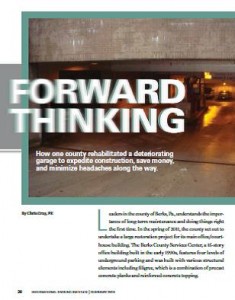Leaders in the county of Berks, Pa., understands the importance of long-term maintenance and doing things right the first time. In the spring of 2011, the county set out to undertake a large restoration project for its main office/courthouse building. The Berks County Services Center, a 16-story office building built in the early 1990s, features four levels of underground parking and was built with various structural elements including filigree, which is a combination of precast concrete planks and reinforced concrete topping.
The initial construction of this facility faced many administrative and technical challenges, resulting in a final product that fell below industry standards for new construction. Furthermore, as with many parking structures of this age, a comprehensive repair and maintenance program was not in place from the time it was built. This combination is a recipe for disaster, as the building declined at more rapid rate than is normal for a parking facility.
Fortunately, the county recognized this and began to allocate appropriate funds to sufficiently restore the facility and take steps towards appointing new personnel to manage and maintain it. These steps showed a renewed commitment from the top down to restore the condition of the garage and transform the facility into a more attractive, safe, and welcoming place for courthouse employees and visitors.
Getting Started
The county’s facility and maintenance personnel quickly realized that the parking garage, which serves as the foundation of the entire facility, was on a fast track to disaster without a comprehensive repair and maintenance program.
Extensive investigative work resulted in the finding that significant structural improvements would be necessary to stop the garage’s deterioration and repair damage already done. The initial assessment uncovered cracking on the top surface of the concrete beams that had resulted in overstressing of the beams and excessive deflection of the structure. The first priority, then, would be to strengthen these beams. Finding the cracks wasn’t all bad as it turned out—their discovery spurred the county to retain a garage restoration specialist, and they were eventually found to be symptoms of many of the issues later discovered during the garage assessment.
Excessive cracking of the concrete surface had led to the accelerated deterioration of embedded structural reinforcement, and ultimately excessive deflection and spalling (chipping, flaking, and scaling) of the concrete. The surface cracking created a direct pathway to the structure’s embedded reinforcement for salts/chlorides to penetrate. To holistically repair the parking garage and ensure the repairs would stand the test of time, it would be necessary to prevent salts/chlorides from getting in and doing even more damage.
The project included reviewing various options with the county to determine the most cost effective long-term maintenance plan to address salt/chloride penetration in the concrete surface. Ultimately, the county decided to follow the recommendation to install a traffic deck membrane on the entire supported floor surface. While initial costs would be higher with the application of a traffic deck membrane than with a traditional silane sealer application, the long-term costs when considering slab replacement and/or demolition that would be necessary for the sealer option or continued apathy would be significantly less.
The repair program included addressing long-overdue life safety, durability, and structural and aesthetic improvements. Some of the existing conditions requiring repair included deteriorated concrete, trench drain repair, cracked piping, exposed electrical conduit, and flaking paint around sprinkler piping. The county understood that these repairs would improve the patron experience (i.e. make their employees happier), while minimizing their own personal liability (i.e. improved structure and reduced potential for slip-and-fall). What’s more, the implementation of these repairs would put money back in their pockets in the long-run. Sound like a win-win-win scenario? That’s because it was!
Phasing it In
Once the necessary repairs and estimated costs were determined, the next consideration was scheduling repair implementation. To offset some of the higher initial costs, the project included the development and implementation of a repair program over several years that would have minimal effect on day-to-day use of the facility. However, the county opted to bite the bullet of higher initial costs and implement the gamut of repairs in one shot. This resulted in a more seamless repair operation, and minimized potential headaches created by a years-long schedule, not to mention savings due to a single mobilization instead of several.
One drawback to implementing the repairs all at once was that the county would need to temporarily relocate parking within the facility—approximately 300 employee spaces—to complete the repairs. Fortunately, replacement employee parking was secured at a reasonable rate from the adjacent parking authority. Lesson learned: No matter what your occupation, never underestimate the importance of establishing a good relationship with your local parking authority!
After determining the repair program, budget, and schedule for repairs, the county chose to move forward with the development of repair documents for bidding and oversight during construction. Experts worked closely with the county to determine operational needs. For example, a police sally port for prisoner booking and a judges’ area for secure access to the courthouse required accelerated repair to mitigate potential security concerns.
The county accepted bids in February 2012 for general, mechanical, and electrical construction services under a multi-prime contract. Contracts were awarded in March and work was completed in October. Despite encountering some unforeseen conditions, such as an existing snow melt system that did not match as-built documents, the determination and creative thinking on the part of the project team have kept repairs on-budget and on-schedule.
The county is currently implementing additional repair programs for facade improvements, as well as plaza improvements under separate contracts. It goes to show that a motivated owner who understands the importance of a comprehensive maintenance and repair program will make the right decisions and save a lot of headaches in the long run.
Chris Gray, PE, is a project manager at Timothy Haahs & Associates, Inc. He can be reached at cgray@timhaahs.com.

